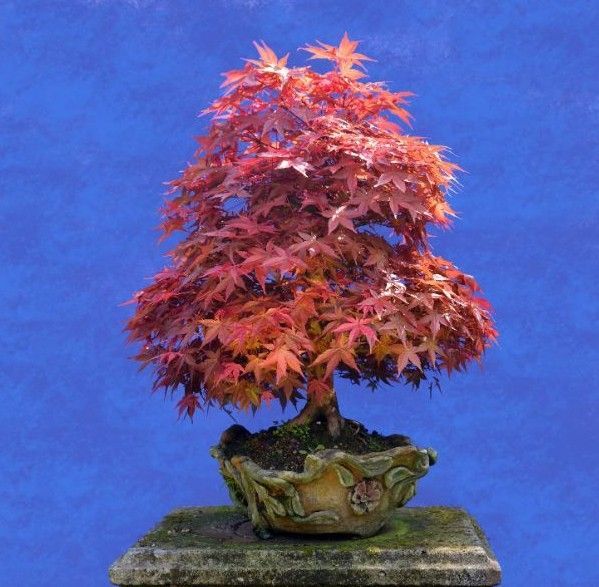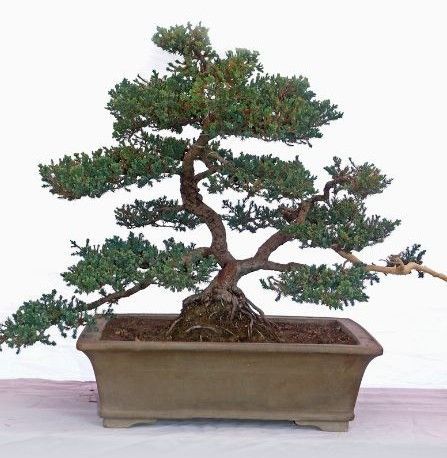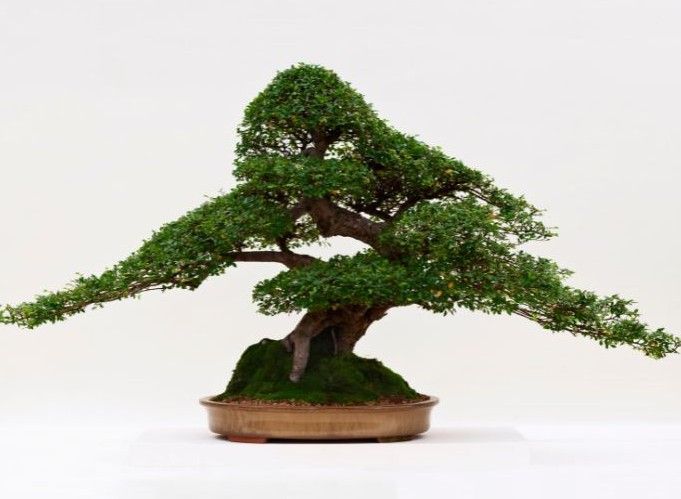Japanese Maple. These hardy frost trees do well outdoors even when trained as bonsai, with proper care, they will be happy outside in conditions as cold as 15 degrees Fahrenheit, any colder place them in a garage.
Bonsai Basics: Everything To Get You Started
Growing A Bonsai Tree
The term bonsai means “grown in a pot”. A bonsai is not a particular species or special plant—any plant can potentially be a bonsai. The goal of bonsai is nurturing and training a plant, typically a tree or flowering shrub, through specialized pruning and wiring techniques to appear as it would in nature. The iconic shallow pot and heavy pruning practices are essential in keeping your tree small and slow growing.
Bonsai is an art studied for centuries, immersed in patience and intention. This is not a project that will be completed overnight, or even in a few weeks. It takes years of research, patience, practice, more patience, and even more practice to achieve what some of the best bonsai masters have achieved. But fret not, because everything any beginner should know is contained in this article. With some research (and practice!), you’ll soon be able to create your own bonsai tree yourself!
Cultivating a Bonsai
Choosing a Species & Location
The first step to creating a beautiful bonsai is to figure out which tree species suits your needs, climate, and circumstances.
For example, your preference to grow your tree indoors or outdoors will have a major impact on your selection. Growing bonsai outdoors is best, and it also gives you more options to choose from. Growing bonsai indoors is not impossible, but your tree will not flourish as it would outside. Think about it—trees evolved to withstand and thrive in the conditions outside, and the conditions inside are harsh and could kill your plant within weeks if proper precautions are not taken.
If growing bonsai outside full-time, be sure to choose a tree or shrub species that can withstand the climate you live in. The best practice for beginners is to choose a species that is native to your area. This will give your bonsai an optimal chance at surviving.
A few types are:
If growing bonsai indoors full-time or part-time, choose a subtropical species that will flourish in those conditions, like a succulent. A few types are:
- Ginseng Ficus – It is a hardy and forgiving tree. They are low maintenance and do not require as much light as other bonsai varieties. They grow well indoors.
- Bougainvillea – These are fast growers and can tolerate a lot of pruning. They thrive in full sun.
- Green Island Fig – It is know for being flexible and easy to take care of. It is well suited for bonsai due to its small size, making it perfect for inside.
- Mini Leaf Elephant Bush - Also known as a Jade plant. Great option for a beginner as it is easy to grow and care for. Maintenance requirements are low.
Buying or Growing Your Bonsai
Once you’ve chosen what species you are interested in cultivating, you’ll want to decide where you’ll get your plant from.
Seed-grown and Wild-caught
The most economical approach is to grow your bonsai from seed or collect it from “the wild”. Wild and seed-grown bonsai take much longer to grow to a point where you can begin to work with them (seed-grown can take up to ten years before they are ready for manipulation). Additionally, trees taken from “the wild” will need special care before you start pruning and shaping them. This special care could take anywhere from a few months to a year or more.
Pre-bonsai and Nursery Plants
The most popular approach to growing bonsai is to purchase a pre-bonsai or nursery stock, which is a great way to achieve quick results.
Pre-bonsai plants are often cuttings taken from larger, mature plants, and styled to look like a bonsai. These tend to be more expensive to buy and will take less work to make it into a true (traditional) bonsai. These are perfect for a beginner that wants to dabble before they dive in.
Nursery plants are the best of both worlds. You have the freedom to choose your plant and have plenty of material to work with to get it looking how you want right away. Some things to look at when picking a nursery or pre-bonsai are:
The root flare and surface roots (nebari)
In traditional bonsai art, the root flare and surface roots are a huge factor in making your tree look like a miniature version of a full-grown specimen. For more advanced cultivators, it’s important to expose and position these roots to create a natural-looking root flare. For beginners, however, pick a specimen that has a thicker base, and you should be good to go.
The overall size shape of the main stem and branches
The next thing to look at when picking a tree to bonsai is the overall shape of the trunk and main branches. The shape of these parts will dictate which styles you can use on the tree. [link “styles” to styles the header below] Most bonsai artists look for a tree with a single trunk coming out of the soil, however, you can use just about any specimen you’d like.
Evidence of pests and disease
For obvious reasons, you don’t want to choose a plant that has evidence of pest infestation or disease. A quick once-over and a short quarantine at home should be enough to discover any critters living on your tree.
Some basic styles you can pick from are:
Shaping and Styling Techniques
Shaping and styling is the fun and creative part of bonsai, but it is also the most challenging, time-consuming part. It can take years to master techniques like jin (a type of deadwood) and nebari (root flare), however, skills like basic pruning and wiring can be learned easily and fairly quickly.
Pruning a Bonsai
The most essential technique in the art of bonsai is consistent and proper pruning. This is crucial in shaping the tree and keeping it small. A bonsai that is left unchecked will continue to grow and eventually become a full-sized specimen.
Before you pick up your shears and cut off branches, you’ll want to 1) understand the way trees grow so you can anticipate and predict what each cut will result in, and 2) study the form of mature trees to know what look you are attempting to achieve. It might sound complicated but hear us out.
There are two main types of pruning techniques: structural pruning – a rigorous, heavy prune to give the bonsai its basic shapes; and maintenance pruning – lighter, more frequent pruning to maintain and refine the existing shape of a bonsai.
Structural Pruning
You can do your first structural prune almost any time during the year. I’m sure there are people out there that swear the fall, or winter, or spring is the best time, but as long as your tree is healthy, and you take proper precautions your tree should survive the prune:
- Use clean, sharp tools, like a concave clipper. Concave tools help the tree to heal faster and leave less of a scar.
- Use a wound sealant to prevent fungal infections.
- Allow the tree to rest and recuperate for a few months before you prune again. You’ll know its time when you notice it begins to grow again.
- Refrain from repotting after you prune your tree for the first time. This will help it bounce back after the heavy prune.
Besides the very first one, you won’t need to do many structural prunes on one particular bonsai, unless you want to change up the style later on.
During a structural prune, you are essentially creating the style of bonsai you wish to achieve. This means that you cut off any branches that do not fit the style you have in mind.
Most beginners are afraid to cut enough off of their tree, and this is understandable. There is a balance between cutting enough off to create a defined shape and cutting too much off and killing the plant. A good rule of thumb is to cut off no more than 1/3 of the foliage at once.
Maintenance Pruning
Maintenance pruning usually happens between one and several times per year. This type of pruning maintains and refines the defined shape you created when you performed your structural pruning. You’ll want to practice the same level of precaution when doing maintenance pruning, like you would during structural pruning. This ensures that your tree remains healthy and strong.
Maintenance pruning involves several tasks that will result in a clean-lined, balanced bonsai:
- Removing downward-facing branches
- Removing branches that cross over others
- Creating “pads” of foliage with space in between
- Developing an overall triangle shape with the foliage
- Removing branches with unnatural twists and turns
- Removing disproportionately thick branches at the top of the tree
- Removing parallel branches or branches next to each other
- Removing branches that stick out of the intended shape of the tree
There are many things for you to pay attention to when pruning your bonsai, which is why patience comes in handy!
Wiring a Bonsai
Another technique to shape Bonsai trees is wiring. By carefully wrapping various-sized anodized aluminum or annealed copper at a 45-degree angle around the trunk and branches, you can bend and shape them to your will, to a certain extent.
It takes a few months before the branches set in their new position, but once the branches have been set, it’s best to remove the wire with wire cutters. Wiring can be applied year-round, if the wire starts digging into branches, remove the wire promptly.
Wire is not required when creating your bonsai, but it is the most effective way to manipulate your tree into the desired shape. Waiting for branches to grow in the places you want is a long, and unpredictable process.
Caring for a Bonsai
Bonsais require a little more attention and care than your typical house or garden plant.
Watering – how much and how often you water your bonsai depends on a lot of factors like tree species, pot size, soil mixture, and climate. Since bonsais are planted in small containers, they tend to dry out quickly, so it is important to water your bonsai regularly if not every day.
Soil and Potting - Choosing the right soil mixture and re-potting regularly is crucial to your tree’s health. A soil mixture with good drainage and moisture retention is best. There are plenty of premixed bonsai potting soils out there; but you can always use store-bought soil amended with pearlite.
Most bonsai need to be repotted every two years to make sure the tree does not become pot-bound, a condition that makes it harder for the tree to soak up water and store nutrients. During this time, you can trim the roots of the tree to ensure they don’t outgrow the next pot right away. This is also the time when more advanced bonsai cultivators work on improving the nebari (root flare) of the tree.
Lighting – Bonsais, often being trees that prefer the outdoors, do best in direct light similar to sunlight. This is the biggest reason bonsais do not do well indoors, however, if you have a grow light that provides near-full spectrum light, you might be able to get away with an indoor tree bonsai. Keep in mind that bonsais in direct sum will need to be watered almost every day, even several times a day, to survive. Most inground trees have roots that run deep and tap into the water table below the surface. Since bonsai trees do not have access to that water, they are more susceptible to drying out.
Feeding – Fertilization is another important thing to keep in mind. Small containers with little space limit water and nutrient retention. Fertilizing consistently in the tree’s growing season will make sure your tree stays healthy and does well, though most bonsai practitioners recommend feeding your tree with diluted fertilizer, every 6 months to prevent overgrowth. Ultimately, the quantity and frequency you fertilize depend on the tree species you have and the conditions it lives in.
Conclusion
The art of bonsai has been around for centuries and can take years to master. Luckily, all it takes to get started is a young tree, patience, and some practice! When it comes to training your bonsai tree, there are many techniques you can use to achieve the look you want. Be patient and take your time. Growing a bonsai tree is a rewarding experience that will give you years of enjoyment.
Check out the latest:












